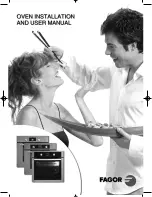
21
Utensils made of china and ceramic excellent to
use in your microwave oven. Most types of glass
are also very good.
Lead crystal glass can crack and should therefore,
not be used. Plastics and paper can also be used,
provided they can withstand the temperature of
the heated food. For cooking only use plastics,
which will withstand a temperature of over 120
,
Eg. polypropene and polyamide. Some plastic
materials, Eg. melamine, will be heated by the
microwave, and be damaged. To find out if a
certain container is suitable, the following simple
test can be made:
Place the empty container and glass of water
inside the microwave oven. The water is needed
because the oven must not be operated empty or
with empty containers only.
Let the oven work on full power for one minute. A
suitable container will only be lukewarm.
Metal containers, Eg. saucepans or frying pans
should not be used in microwave ovens. Nor
should plates or vessels with decorations be used
since metal Eg. gold, might be part of the
decoration and such decorations will be damaged.
Small pieces of aluminiuum foil can be used, but
only to shield the areas that would over-cook (Eg.
for covering chicken wings, leg
tips and fish tails) but the foil
must not touch the side of the
oven as damage may occur.
WHICH UTENSIL CAN BE USED IN THE OVEN?
Glass (general)
Yes (1)
Glass (heat resistant)
Yes
Glass-ceramic and
ceramic (heat resistant)
Yes (1)
Earthenware
Yes
China (heat resistant)
Yes
Plastic (general)
Yes (2)
Plastic (heat resistant)
Yes (2)
Aluminium foil con-
tainers/aluminium foil
Yes (3)
Metal baking tins
No
Metal (pots.pans, etc)
No
Paper Yes
1. Without metal parts or metal trims.
2. Some plastics are heat-proof only to certain
temperatures. Check carefully!
3. It is possible to use aluminium foil to shield
deliate areas of food (this prevents over-
cooking).
Caution:
• There are a number of accessories available
on the market. Before you buy, make sure
they are suitable for microwave use.
• When you put food in the microwave oven,
make sure that food, food supports or
covering do not come in direct contact with
any of the internal walls or the ceiling of the
cavity since discolouration may take place.
Only use utensils that are suitable for use in microwave ovens.
Before use, the user should check that tensils are suitable for use in microwave ovens.
Material
Microwave cooking
Microwave function only
Utensils and cooking containers used in a
microwave oven should be of a material that does
not act as a barrier to microwave energy.
Generally this means that you should cook in
either (paper), plastic, glass or ceramic.
Metal pans reflect microwave energy and inhibit
cooking, and should not be used. In addition to
material, the shape of the container should also
be considered.
Round oval shapes give the most even cooking.
Square or rectangular containers may over-cook
foods in the corners because more energy is
absorbed there.
Shallow containers give more even cooking
results.















































